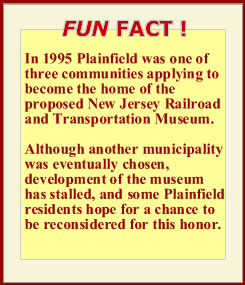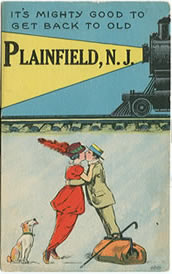| |
 |

 |
The adage says “the more things change the more they remain the same”, however where transportation in Plainfield, things have changed immensely from the first settlers till now. Plainfield has moved beyond the tiny two street town where first settlers sought religious freedom or the bustling industrial city of the 1920's and 30's to a suburban community with 21st century concerns about transportation. |
Plainfield’s problem solvers began again to address transportation problems in 1970 when Plainfield’s Planning Division issued “A Short Range Plan for Transit.” This report deals particularly with residents most dependent upon public transportation. It stated, “At the present time, however, amelioration of inconvenience and financial burden for those requiring public transit in order to reach hospital facilities is our main concern.
Challenges remain. The segment of Plainfield’s population that has ready access to automobiles causes other significant issues. Growing problems facing the city today are parking availability as well as the pollution caused by automobile exhaust. Future innovations may provide relief to these growing concerns. |
It is not uncommon in downtown Plainfield to see large numbers of people walking, catching a bus or taking a taxi to their destinations. A large amount of foot-traffic must co-exist on busy streets traversed heavily by cars, trucks and buses. Accidents are not uncommon here. Traffic regulations, crossing guards, and timed lights help to maintain safety. |
|
Public parking facilities have aided the commuter population immensely so that they are well served by North Avenue and the Netherwood train stations along the New Jersey Transit’s Raritan Valley Line. Both stations have undergone extensive restoration and renovation over the past decade.
|
As Plainfield looks beyond its important transportation history, it is interesting to note that there are ongoing discussions among local government officials and city planners about the development of Transit Villages. In 2006, the new administration has hired a company to plan the redevelopment of areas around the main station going all the way South to Seventh. This would involve the construction of commercial and residential use buildings that would cater to commuters using trains located very close by. |
 |
 |
Redevelopment, restoration, and preservation have become Plainfield bywords. Local residents in these areas are anxious to preserve the character of their neighborhoods. Some collect vintage vehicles including cars, trucks, and even trains. Others seek images of their original homes in order to restore them exactly. On the other hand to new residents move to Plainfield to restore early houses and anticipate an easier ride to New York. There is a continual push and pull between one group in town that wants to restore the former town and the other that wants to redevelop. |
Many of the early forms of transportation still exist though different in design. One can even find a horse and buggy or a sleigh to rent around the holidays. Children are still biking and skating. Car and truck manufacturers have moved from Plainfield to larger manufacturing areas. Many families own automobiles. Manufacturers are considering building electric cars because of oil shortages and pollution. The historic images shown here reflect nationwide activity and change and will be followed someday by newer images revealing technological changes in transportation and the city. Life in New Jersey is on track to the future. Plainfield is on the move. |
 |
|
|
Copyright 2007, Plainfield Public Library. All Rights Reserved |
|
|
